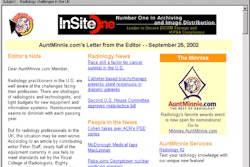Washington Managed Imaging
As you look around your marketplace, you notice that the number of local providers -- institutional, primary care, specialists, or ancillary service providers -- is steadily decreasing as the penetration of managed care increases. You begin to wonder if your group will be next. In addition, you’ve noticed that you’re working much harder to maintain your previous income level. You wonder how your group can survive and compete while retaining its independence.
So you and your partners meet to discuss your strategic alternatives. Someone suggests that selling out to a hospital might make sense, since the professional fees you derive from your hospital contract account for the great majority of your annual incomes. Why not protect this income through a partnership with the hospital?
Another partner suggests selling out to a multispecialty group -- which would then provide you each with long-term employment contracts -- and assume the headaches of managing your business. Yet another partner suggests that perhaps you should merge with one or more other radiology practices in your area, because "bigger is better."
So what do you do? Often, the idea of forming (or joining) a radiology network is not even mentioned, although it’s the least-risky strategy to provide needed benefits to radiology providers.
If you’re like many other radiologists, you leave your strategy meeting worried, but still unsure of your ultimate destiny. While each of the above-mentioned alternatives may have merit, the question is which of them, if any, are best for your group? A radiology network model deserves serious consideration. Let’s take a closer look at each of the alternatives.
Selling to a hospital system
Many hospitals are interested in employing, or, in those states where such arrangements are illegal, closely affiliating with their hospital-based specialists. In this era of managed care, it’s clearly to the hospital’s advantage to be able to contract for its technical facilities, as well as for its in-house physicians who provide professional services.
Managed-care payors like the idea of executing a single contract to obligate as many providers as possible. After all, such arrangements reduce the administrative costs of running a health plan. And how many hospital administrators have had their hair turn various shades of gray because of their dealings with "unruly" hospital-based specialists?
For interested radiology groups, there are bound to be willing hospital buyers for their services. And those buyers may very likely pay in cash. But what does selling to a hospital system mean for the radiologists?
First, it means they become employees of the hospital, no longer free to make independent decisions about the way they practice, their finances, or much of anything else. It also means that, at the conclusion of their guaranteed employment term, they are subject to continued employment at the hospital’s whim. My sense is that most radiologists, with the possible exception of those nearing retirement, would not be comfortable with such an arrangement.
Selling to a multispecialty group
This alternative might seem preferable to selling to a hospital, since at least a multispecialty group is composed of physicians. And it’s quite likely that the radiologists could be offered partnerships in the multispecialty group to mirror their partnership status in their former group.
Taking a closer look at these arrangements, however, can yield a different picture. Although some multispecialty groups dominate their geographic areas and are able to pay their members at premium levels, not all groups have that luxury. While most may claim to be able to increase their members’ salaries through a combination of business efficiencies and increased patient volumes via large managed contracts, the reality is that these goals have proven to be somewhat elusive for many.
However, many large groups have neared (or declared) bankruptcy as a result of one or more supposedly "lucrative" managed-care contracts that went bad. Furthermore, and perhaps most significantly, it is a rare multispecialty group in which radiologists are given leadership positions, or for that matter, are paid in a manner that is equal to other specialists in the group.
On the contrary, in most multispecialty groups the radiologists have little power to create or affect group policies, and in fact are often seen as "bringing up the rear of the train." These groups can be very large, to the point where some radiologists know little or nothing about some of their new partners.
Independence is something that’s mortgaged once the transaction to sell to the multispecialty group is signed. Most radiologists tend to view these deals as more negative than positive, especially over the long haul. Hoped-for long-term security can instead turn into an unpleasant group-practice setting from which it can be difficult to extricate.
Merging with one or more other radiology groups
Many smaller radiology groups have decided to merge with larger groups. The allure of becoming part of a large radiology group, with its potential group purchasing and contracting advantages, can outweigh the concerns of loss of independence. I’m a proponent of this strategy, since I believe that it’s only a matter of time before small independent groups are put at such a competitive disadvantage that they can’t survive. But it’s important for radiologists to approach mergers with their eyes open.
Realize that such deals, no matter how large or small, always seem to take longer to accomplish than you first expect. Countless hours are spent in night meetings, during which the deal points of the merger are hammered out and the partners from the merging groups get to know each other.
Key issues such as compensation, time off, call, coverage, and governance always seem to require almost endless negotiation. And the due diligence process, during which each group’s financial and clinical representations are substantiated, can involve multiple months of effort for your business staff, consultants, and lawyers -- each of whom will be expensive. I believe that a merger is a logical alternative for radiologists to pursue. But mergers invariably encompass time, money, and frustration that radiologists fail to plan for on the front end. And once accomplished, mergers are usually quite difficult to unwind.
Forming or joining a radiology network
For radiology groups looking to pursue a strategic alternative to strengthen themselves, yet maintain their independence, a radiology network can make sense. A network is a legal entity which has the power to contract with payors, vendors, and others on behalf of its members, but whose members retain the right to participate (or not participate) in each of those contracts -- other than capitated contracts with payors, for which participation is required.
The cost to join an existing radiology network is usually minimal, or sometimes nothing at all. And the cost to maintain your group’s membership is usually quite insignificant. New networks can be formed on a relative shoestring. The members of California Managed Imaging Medical Group, a pioneering radiology network in the U.S., spent hundreds of thousands of dollars on legal fees to form their entity, paving the way for others to follow. Often, a network can be formed for a few thousand dollars in legal fees, primarily for the drafting of the network’s bylaws and membership agreement.
Once formed, the network can pursue group contracts with malpractice carriers, equipment vendors, service vendors, film vendors, and information technology vendors (such as information systems and PACS) that can reduce costs for each of its member groups. It can negotiate network contracts with payors, often at terms and conditions more advantageous than those that small member groups could command on their own.
Moreover, the network’s members can work together to establish needed systems for quality assurance and utilization review, which most members will need to do whether or not they join a network. Obviously, network members must be careful to observe antitrust statutes in their interactions with each other. Such statutes are quite clear about issues such as price fixing and market power, so most networks incur some legal fees to ensure that they are in compliance with antitrust laws.
Physician network success factors
A network’s success is dependent on a few key factors. First, an active board should direct the network’s activities. The board should elect a president who has the time and commitment to support the network over the long term.
The network should hire a capable, experienced executive director to manage its activities on a day-to-day basis, working closely with the president. The executive director should be charged with the responsibilities of developing and managing all of the network’s business, whether it is with vendors, payors, or subcontractors such as management services organizations (MSOs). The executive director should be given guidelines from the board so that the contracts that are negotiated have the best chance of being successful across the network. And network costs must be closely managed.
A major reason why some networks fail is that their members are asked to spend too much money on network overhead before significant network benefits can be realized. That problem can be reduced through the virtual-office model.
With computer technology, it is quite possible for the network to be run on a virtual basis, thereby saving considerable overhead costs, while utilizing the services of an MSO to manage its payor contracts on a remote basis. Without an MSO, the network could be forced to spend a considerable amount of money on computer hardware, software, and employees to manage its payor contracts.
An MSO offers the advantage of charging a fixed amount of money only after the network successfully obtains contracts, and saves the network from having to invest in systems. A virtual office, as opposed to one that incurs monthly expenditures for rent, office equipment, utilities, supplies, and so on, can save the network considerable amounts of money, while providing the same (or better) levels of service to the network’s customers. Home-office technology can now make almost any office appear to be the headquarters of a major corporation.
Another important way to reduce expenses is by minimizing the use of outside consultants. Having been down this path myself, I strongly recommend that the network avoid utilizing outside consultants to perform market research, financial, or actuarial studies. Although these can occasionally provide value, their cost tends to be quite high, and their applicability to your market can be dubious.
If you’re considering forming or joining a radiology network, you and your partners should already have a good idea of your major customers. It doesn’t do much good to hire a consultant to interview these potential customers because the customers will probably have a very limited understanding of the radiology network concept. Educating potential customers will be the responsibility of your executive director. Let that person do their job.
The same is true for financial budgeting or actuarial studies. Your executive director should be both capable and experienced enough to produce this information internally, or to know where to find it (through sources such as professional associations) at minimal cost.
Local and regional networks
Radiology networks can be formed almost irrespective of geography. Your network should be formed (or joined) depending upon the specific circumstances of your practice. Radiology networks have been formed in California, Washington, the Rocky Mountain area, the Chicago area, Georgia, central Pennsylvania, New York, New England, and other locations.
Some have been statewide; others are regional or more localized. Not all have survived, owing primarily to a lack of managed-care contracts. But even in those cases, the investment lost by radiology groups in defunct networks is typically minimal. And in today’s market, with the shortage of radiologists and with many managed-care payors anxious to contract with radiologists in a simpler manner, the market is more receptive to our radiology network.
The network model provides radiologists with several key advantages: the opportunity to work closely together with their peers; the chance to realize savings through group purchasing; the chance to participate in larger-scale managed-care contracts; and the protection of the radiologist’s independence on a short- and long-term basis.
Unlike mergers or sales, it is relatively easy to join (or leave) a network at any time. Hard dollar costs can be minimal, depending upon the number of network members. Well-run networks can produce annual returns close to, or exceeding, 100% through a combination of reduced costs and increased revenues at the individual radiology group level.
Once formed, it’s important for the executive director and board to keep in constant communication with network members. Because a network is basically an independent practice association, the tendency is for members to not pay close attention to the day-to-day activities of the organization. This is perfectly acceptable, so long as the membership is kept informed about their network via tools such as e-mail or a Web site.
Meeting minutes should be distributed to all members, and meetings should be accessible via teleconference facilities for those members located in outlying areas. The executive director should act as an internal consultant to the members, adding expertise to help solve their issues whether or not they directly affect the network. If members receive value, they will remain loyal. If not, no one can blame them for leaving the organization.
By Michael S. FentonAuntMinnie.com contributing writer
July 15, 2002
Michael Fenton is executive director of Seattle-based Washington Managed Imaging, a radiology network encompassing 14 private-practice radiology groups and more than 250 board-certified radiologists. The company currently holds 10 managed-care payor contracts covering approximately 1.4 million members in Washington. For more information, visit the company’s Web site at www.wmi-radiology.com.
Related Reading
Surviving and thriving in a radiology group merger, June 6, 2002
Marketing plan charts course to success for radiology group, June 5, 2002
RPAs may offer solution to strapped radiology practices, October 25, 2001
Regulatory compliance plans are key to avoiding legal risk, October 25, 2001
Joint ventures can help radiology groups survive APCs, July 18, 2001
Copyright © 2002 Washington Managed Imaging



















